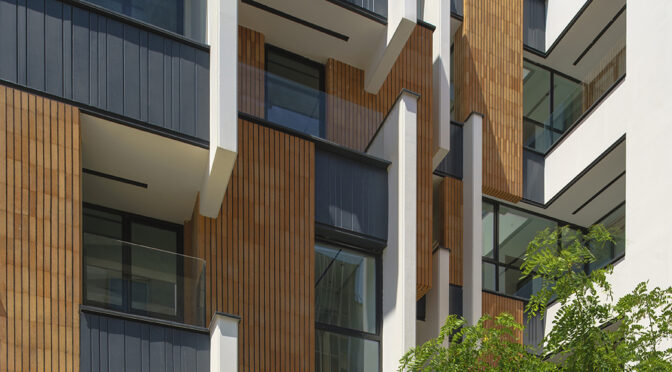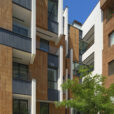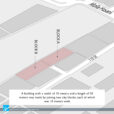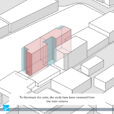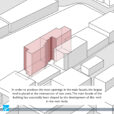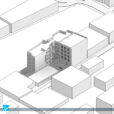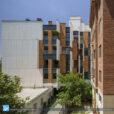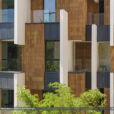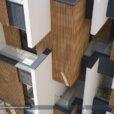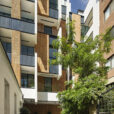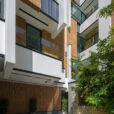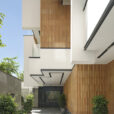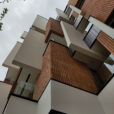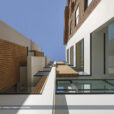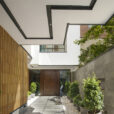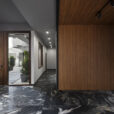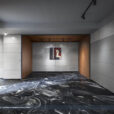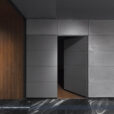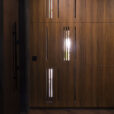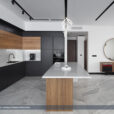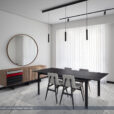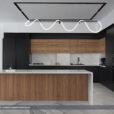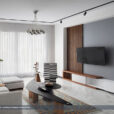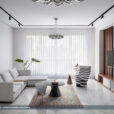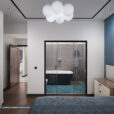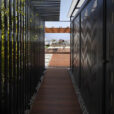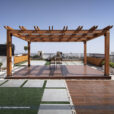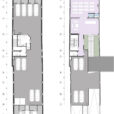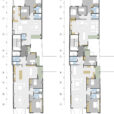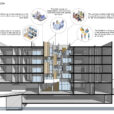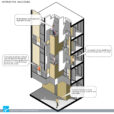ساختمان مسکونی روژه
دفتر معماری ایده همساز (رئوف قاسمی)
موقعیت: تهران، ایران
تاریخ: ۱۴۰۱
مساحت: ۱،۹۵۰ مترمربع
وضعیت: ساختهشده
کارفرما: محمد مدرس تنکابنی، محسن نیکنژاد
تیم طراحی: حامد سلیمانی، حمید شاکری، انسیه گنجی، محمد رحمتی، مریم مسکار
طراحی داخلی واحدها: ژیلا نوروزی
سازه و تاسیسات: شرکت ایستاساز تمجید
اجرا: شرکت تکا، شرکت نیکتراز ساخت
مدیریت اجرا: مجتبی برزگری، محمد رسولی، احسان بیگی، رسول رستمی
اجرای نما: علیرضا عسکری، آریا عسکری، هادی شیردل، مهدی عمادی
عکس: استودیو دید، استودیو نیمکت
ساختمان مسکونی روژه در بافت کوچهباغی منطقه نیاوران تهران، در انتهای کوچهای بنبست قرار گرفته است. این بنبست به دو ملک همسایه ختم میشد که بر خلاف روش متداول تجمیع که از طول دو ملک مجاور هم صورت میپذیرد، از عرض با یکدیگر تجمیع شده بودند. نتیجه این تجمیع نامتعارف، زمینی به ابعاد حدودی ۱۰ در ۶۰ متر، با دسترسی از وسط ضلع طولی بود که امکان ساخت یک زیرزمین و چهار طبقه ۶۵ درصدی روی همکف را داشت، و میبایست هشت واحد در مجموع، یعنی دو واحد شمالی (دوخوابه) و جنوبی (سهخوابه) در هر طبقه طراحی میشد.
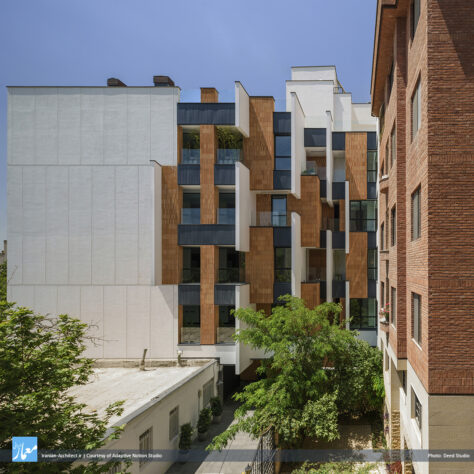
با توجه به دسترسی بنا از وسط ضلع ۴۵ متری طولی، نحوه قرارگیری نورگیرها و بهویژه، نورگیری واحد شمالی به مسئله اصلی پروژه تبدیل شد. با اتودهای متفاوتی که روی نورگیرهای پروژه صورت پذیرفت، نورگیر اصلی در قسمت میانی ضلع شرقی (انتهای بنبست) تعریف شد که این نورگیر امکان دریافت نور جنوب را برای واحدهای شمالی فراهم و آنها را از واحدهای شمالی متعارف مجزا میکند. با توسعه این نورگیر، عملا بدنه شرقی به نمای اصلی ساختمان و نیز مرکز اصلی پویایی واحدها مبدل شد. از اینرو، تمامی تراسهای کوچک اتاقها در همین نورگیر تعبیه شدند، و برای کنترل دید تراسها نسبت به یکدیگر، تیغههایی عمودی مابین آنها در نظر گرفته شد.
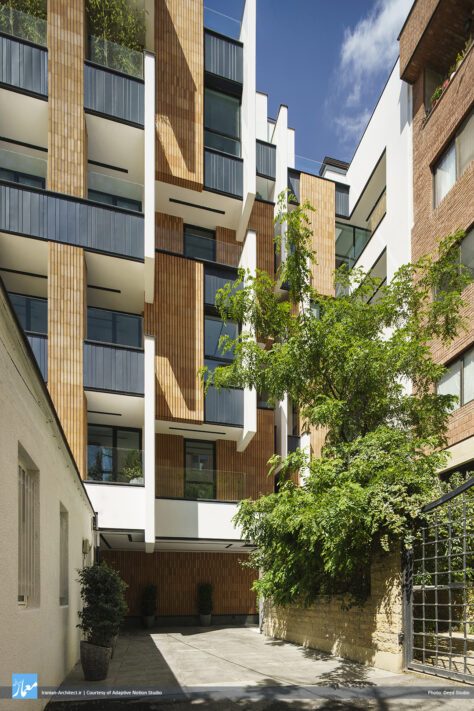
در واحدهای جنوبی، دو اتاق بهواسطه تراسهایشان از نورگیر میانی تغذیه میشوند. یکی از این اتاقها با دسترسی جداگانه از بیرون واحد، بهصورت یک دفتر کار کوچک یا اتاق مهمان مستقل در نظر گرفته شده که با چرخش در هر طبقه، تراسهای متفاوتی را برای هر یک از واحدهای جنوبی ایجاد کرده است.
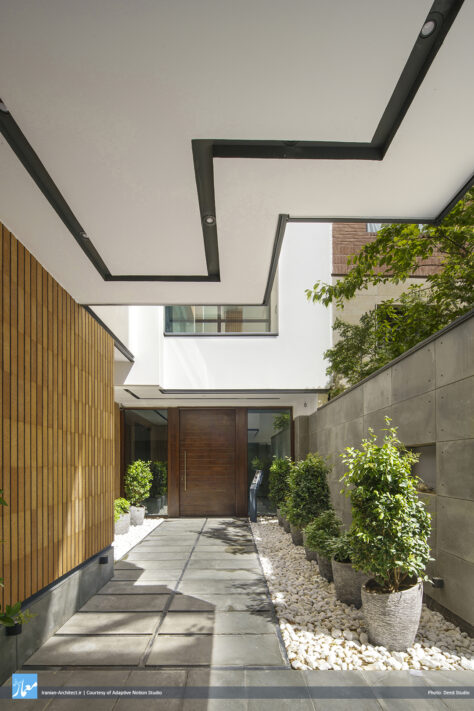
یکی از دستاوردهای نورگیر میانی پروژه، ایجاد یک ورودی با یک حیاط کوچک است؛ مسیر دسترسی به ساختمان به یک فضای ۵ در ۵ میانی میرسد که این فضا از سمت چپ به پارکینگ همکف و رمپ پارکینگ زیرزمین، و از سمت راست به یک حیاط کوچک و سپس لابی منتهی میشود. لابی نیز بهگونهای طراحی شده است که همانند یک گالری هنری، محلی برای نصب تابلوهای نقاشی یا هنری مشابه باشد.
با توجه به قرارگیری ساختمانی با نمای آجری در کنار پروژه، سعی شد بنای جدید در ارتباطی آرام با این بنا قرار گیرد. از اینرو، نمای اصلی پروژه ترکیبی از آجر و سیمان سفید در نظر گرفته شد که بیشترین حجم آجر آن در قسمتهای مجاور ساختمان آجری کناری است.
Roje Residential Building
Adaptive Notion Studio (Raouf Ghasemi)
Location: Tehran, Iran
Date: 2022
Area: 1,950 sqm
Status: Completed
Client: Mohammad Modarres Tonekaboni, Mohsen Niknejad
Design Team: Hamed Soleimani, Hamid Shakeri, Ensieh Ganji, Mohammad Rahmati, Maryam Meskar
Interior Design of Units: Jila Norouzi
Structure & MEP Engineering: Istasaz Tamjid Company
Construction: TKA Company, NTS Company
Construction Management: Mojtaba Barzegari, Mohammad Rasouli, Ehsan Beigi, Rasool Rostami
Facade Construction: Alireza Askari, Aria Askari, Hadi Shirdel, Mehdi Emadi
Photo: Deed Studio, Nimkat Studio
Roje residential building is located at the end of a dead-end alley in Niavaran district of Tehran. This alley ended with two neighboring properties. These two properties have been combined with each other from the width, unlike the common method of consolidation that is done from the length of two adjacent properties, which results in a land with dimensions of approximately 10m × 60m, with access from the middle of the long side. In this land, it was possible to build a basement and four floors with 65% on the ground floor, and eight units in total, namely two north (two-bedroom) and south (three-bedroom) units should be designed on each floor.
Due to the access of the building from the middle of the 45m long side, the placement of the voids and lighting the northern unit, became the main issue of the project. With various etudes on the voids of the project, the main void was defined in the middle part of the eastern side (the end of the dead end), which allows the northern units to receive southern light and separates them from the conventional northern units. With the development of this void in the east body, this body practically became the main facade of the building as well as the main dynamic center of the units. Therefore, all the small terraces of the rooms were placed in the same void, and to control the view of the terraces to each other, vertical blades were considered between them.
In the south units, two rooms are fed by the middle void through their terraces. One of these rooms with separate access from the outside of the unit, was considered as a small and separate office or guest room, which has created different terraces for each of the south units, by rotating on each floor.
Another feature of the middle void is to create an entrance with a small courtyard. The access path to the building reaches a middle 5m × 5m space, which enters the ground floor parking and underground parking ramp, from the left side, and it reaches the small courtyard and then the lobby, from the right side. Next, the lobby was designed to be like to a local gallery for installing paintings or similar.
Due to the placement of a building with a brick facade, next to the project, the new building was placed in a calm relationship with this building. Therefore, the main facade of the project was considered a combination of brick and white cement, with most of the volume of brick in the adjacent parts of the neighbor brick building.

